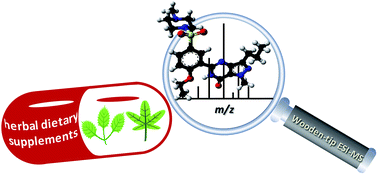Rapid detection of adulterated drugs in herbal dietary supplements by wooden-tip electrospray ionization mass spectrometry†
Abstract
Adulteration of herbal dietary supplements with unlabelled drugs is illegal and can lead to serious health problems in consumers. In this study, wooden-tip electrospray ionization mass spectrometry (WT-ESI-MS) was developed for rapid detection of adulterated drugs in three categories of herbal dietary supplements, namely tranquilizer, aphrodisiac and weight-loss products. Samples were directly taken by using pre-wetted wooden tips and analyzed by WT-ESI-MS, with the drug identities confirmed by MS/MS spectra. Furthermore, a high-throughput WT-ESI-MS method was developed to allow automated WT-ESI-MS and MS/MS analysis of herbal dietary supplement samples with an analysis speed of ∼15 seconds per sample. The limits of detection of typical drugs were found to be at the ng g−1 level using the WT-ESI-MS method. In this study, 33 commonly adulterated drugs were investigated and a spectral database containing the ESI-MS and ESI-MS/MS spectra of these drug standards was established. A total of 144 herbal dietary supplements were analyzed and the results were compared with those obtained by using high performance liquid chromatography. These results demonstrated a simple and comprehensive approach for rapid detection of adulterated drugs in herbal dietary supplements.


 Please wait while we load your content...
Please wait while we load your content...